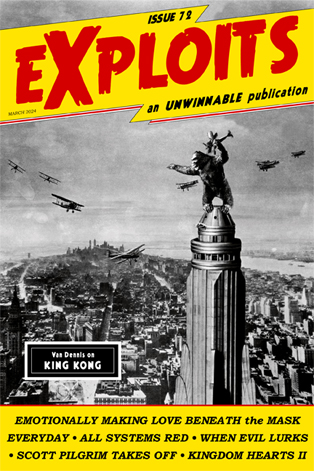
The Century-Long Humanification of King Kong
 This is a reprint of the feature essay from Issue #72 of Exploits, our collaborative cultural diary in magazine form. If you like what you see, buy it now for $2, or subscribe to never miss an issue (note: Exploits is always free for subscribers of Unwinnable Monthly).
This is a reprint of the feature essay from Issue #72 of Exploits, our collaborative cultural diary in magazine form. If you like what you see, buy it now for $2, or subscribe to never miss an issue (note: Exploits is always free for subscribers of Unwinnable Monthly).
———
It feels weird that, despite existing for over 90 years now, King Kong’s filmography encompasses just ten movies, and that’s including this year’s Godzilla x Kong: The New Empire, along with two Japanese entries made by Godizlla’s parent company Toho. Still, the big ape’s cinematic catalog reveals something surprised when viewed in its entirety: a steady progression of character development. Despite starting out as a basic movie monster, King Kong achieved a sort of self-actualization over the decades, thanks to each subsequent filmmaker adding more depth with each incarnation.
Calling the original 1933 King Kong “basic” feels a bit harsh, as even in his first outing Kong carries thematic baggage. The core conflict is exoticism clashing with modernism: a beast from a primitive world that is ultimately defeated by “foolishly” climbing up and falling off of one of the most famous pieces of modernist architecture in existence. Kong’s kidnapping of Ann Darrow also arguably represented then-contemporary racial anxieties, an on-screen depiction of societal fears over a relationship that went against the norms of the time (it was common for movie monsters from the 1920s through ’50s to terrorize white women and be subsequently defeated by heroic white men).
Subsequent adaptations see Kong depicted in much more empathetic ways. 1976’s King Kong is a messy remake that tries to be a grounded adaptation and a comedy at the same time, but it nevertheless depicts Kong as a tragic antagonist. Sure, he kidnaps a hot white lady again, but Jessica Lange’s character forms a sort of “bond” with what is ultimately just an oversized (but still quite dangerous) gorilla. Peter Jackson’s 2005 remake is the first movie that works to make Kong a character with depth: he’s shown to be a lonely king, the last of his kind, who, before his demise, shows an understanding of “beauty.” The relationship between beauty and beast here is a true and tragic friendship, which makes this version of Ann Darrow the most fleshed out in Kong’s filmography as well.
Finally, there is the modern-day Monsterverse Kong where, despite being unabashed action movies, the titan is actually at his most thoughtfully written. In 2017’s Skull Island, Kong is plainly explained to be defending his home from invading soldiers and invasive species, and in 2021’s Godzilla vs Kong, he now talks with people for the first time through sign language.
Across a century, King Kong has evolved from a villain whose demise the audience cheers, to a quasi-protagonist we now empathize with and actively root for to save humanity from much worse dangers. Perhaps this long arc of character development reflects how audiences have developed over the years: instead of seeing a “monstrous” creature as an entity that must be destroyed, viewers can now see the unfamiliar “other” as something (or someone) worthy of existence, and even understanding.




